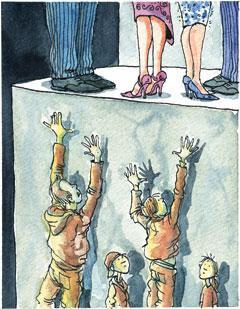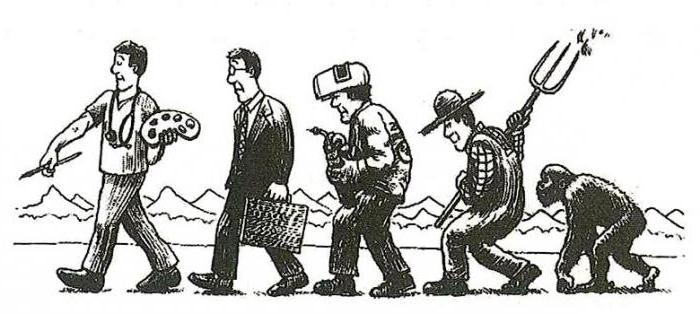Thanks to social mobility, members of society can change their status within society. This phenomenon has many features and characteristics. The nature of social mobility varies depending on the characteristics of a particular country.
The concept of social mobility
What is social mobility? This is a person’s change in his place in the structure of society. An individual can move from one social group to another. Such mobility is called vertical. At the same time, a person can change his position within the same social layer. This is another mobility - horizontal. Moving takes a variety of forms - rising or falling prestige, changing income, moving up the corporate ladder. Such events have a serious impact on a person’s behavior, as well as his relations with people around him, attitudes and interests.
The above types of mobility took modern forms after the emergence of an industrial society. The ability to change one’s position in society is an important sign of progress. The opposite is the case of conservative and class societies where castes exist. As a rule, a person is assigned to such a group from his very birth to death. The Indian caste system is best known. With reservations, similar orders existed in medieval feudal Europe, where there was a great social gap between the rich and the poor.

History of the phenomenon
The emergence of vertical mobility became possible after the start of industrialization. About three hundred years ago, the industrial development of European countries accelerated significantly, which led to the proliferation of the proletarian class. At the same time, states around the world (with varying degrees of success) began to introduce an accessible education system. It has become and still is the main channel of vertical social mobility.
At the beginning of the 20th century, most of the population of any country were workers without qualifications (or with the beginnings of general education). At the same time, mechanization and automation of production took place. A new type of economy required more and more highly qualified personnel. It is this need that explains the increase in the number of educational institutions, and hence the opportunities for social growth.

Mobility and Economics
One of the features industrial society such that mobility in it is determined by the structure of the economy. In other words, the opportunities for climbing the social ladder depend not only on the personal qualities of a person (his professionalism, energy, etc.), but also on how the various sectors of the country's economy are interconnected.
Mobility is far from everywhere. It is an attribute of a society that has given equal opportunities to its citizens. And although absolutely no equal conditions exist in any country, many modern states continue to move towards this ideal.
Individual and group mobility
In each country, the types and types of mobility are represented differently. Society can selectively raise some individuals along the social ladder and lower others. This is a natural process. For example, talented and professional people must definitely replace the more mediocre and get their high status. Lifting can be individual and group. These types of mobility differ in the number of individuals changing their status.
In the individual case, a person can increase his prestige in society thanks to his talents and hard work (for example, to become a famous musician or receive a prestigious education). Group mobility is associated with much more complex processes, covering a significant part of society. A striking example of this phenomenon can be changes in the prestige of the profession of engineers or a drop in the popularity of the party, which will necessarily affect the position of members of this organization.

Infiltration
In order to achieve a change in his position in society, the individual must make certain efforts. Vertical mobility becomes possible only if a person is able to overcome all the barriers that lie between different social layers. As a rule, climbing the public ladder is due to ambitions and the individual's need for his own success. Any kind of mobility is necessarily associated with the energy of a person and his desire to change his status.
The infiltration that exists in every society eliminates people who have not put in enough effort to change the social stratum. The German scientist Kurt Levin even deduced his own formula, with which you can determine the likelihood of a particular person ascending in the social hierarchy. In the theory of this psychologist and sociologist, the most important variable is the individual's energy. Vertical mobility also depends on the social conditions in which the person lives. If he meets all the requirements of society, then he will be able to undergo infiltration.
The inevitability of mobility
There are at least two reasons for the existence of the phenomenon of social mobility. Firstly, any society invariably changes in the process of its historical development. New features may appear gradually, or may instantly, as is the case with revolutions. One way or another, but in any society, new statuses undermine and replace old ones. This process is accompanied by changes in the distribution of labor, goods and responsibilities.
Secondly, even in the most inert and stagnant societies, no power can control the distribution of abilities and talents that is natural in nature. This principle continues to apply if the elite or power monopolizes and limits the availability of education. Therefore, there is always the possibility that the top layer will be replenished at least periodically by worthy people “from below”.

Generational Mobility
Researchers single out another feature by which social mobility is determined. This measurement may be a generation. What explains this pattern? The history of the development of various societies shows that the situation of people of different generations (for example, children and parents) can not only differ, but, as a rule, is different. Evidence from Russia confirms this theory. On average, with each new generation, residents of the former USSR and the Russian Federation gradually climbed and are rising up the social ladder. This pattern also holds true in many other modern countries.
Thus, when listing types of mobility, one should not forget about intergenerational mobility, an example of which is described above. In order to determine progress on this scale, it is enough to compare the position of two people at a certain point in career development at approximately the same age. The measure in this case is the rank in the profession. If, for example, a father at the age of 40 was the head of the workshop, and a son at this age became the director of the plant, then this is intergenerational growth.
Factors
Sluggish and gradual mobility can have many factors. An important example in this series is the relocation of people from agricultural regions to cities. A major role in the history of all mankind has been played by international migration, especially since the 19th century, when it spread throughout the world.
It was in this century that the vast masses of the peasant population of Europe moved to the United States. You can also give an example of the colonial expansion of some empires of the Old World. The seizure of new territories and the subjugation of entire nations was fertile ground for lifting some people and sliding down the social ladder of others.

Effects
While horizontal mobility for the most part affects only a specific individual or group of people, then vertical mobility entails much greater consequences that are difficult to measure. There are two opposing points of view on this score.
The first says that any examples of mobility in the vertical direction destroy the class structure of society and make it more homogeneous. This theory has both supporters and opponents. On the other hand, there is a point of view according to which, a high level of social mobility only strengthens the system of social strata. This happens for the simple reason that people who are at a higher level of position become interested in maintaining class differences and contradictions.
Speed
According to sociological science, the main types of social mobility have an indicator of their own speed. With its help, experts quantify this phenomenon in each specific case. Speed is the distance an individual travels over a period of time. It is measured in professional, political or economic strata.
For example, one university graduate in four years of his career managed to become the head of a department at his enterprise. At the same time, his classmate, who graduated from the university with him, became an engineer by the end of the same period. In this case, the speed of social mobility of the first graduate is higher than that of his comrade. This indicator can be influenced by a variety of factors - personal aspiration, a person’s qualities, as well as his environment and circumstances associated with working in a company. The high speed of social mobility may be inherent in the processes opposite to the above, if we are talking about a person who has lost his job.

Intensity
Considering 2 types of mobility (horizontal and vertical), you can determine the number of individuals changing their position in society. In different countries, this indicator gives different numbers. The larger the number of these people, the higher the intensity of social mobility. Like speed, this indicator demonstrates the nature of internal transformations in society.
If we are talking about the actual number of individuals, then the absolute intensity is determined. In addition, it can also be relative. This is the name of intensity, determined by the proportion of individuals who have changed their position from the total number of members of society. Modern science gives different assessments of the importance of this indicator. The combination of intensity and speed of social mobility determines the overall mobility index. With it, scientists easily compare the state of different societies.

The future of mobility
Today, in Western and economically developed societies, horizontal mobility is becoming significant. This is due to the fact that in such countries (for example, in Western Europe and the USA), society is becoming more and more classless. Differences between layers are blurred. This is facilitated by a developed system of affordable education. In rich countries, anyone can learn, regardless of their origin. The only important criterion is his interest, talent and ability to acquire new knowledge.
There is another reason why in modern post-industrial society previous social mobility is no longer relevant.Moving upward is becoming more and more conditional if we take the size of income and financial well-being as a determining factor. Today, a stable and prosperous society can introduce social benefits (as is done in the Scandinavian countries). They smooth out contradictions between people on different steps of the public ladder. This erases the boundaries between familiar classes.
